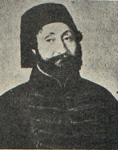

Pipe ('The Boru')
Called "borı, borgay" in ancient sources which, in turn, is derived from "burgü, burgu" (spiral). Arabs,, have also called this "nefir". Initially it was made from barks later it was made by curling copper or brass plates. It is said to be an invention of Alpaslan. This wind instrument with a curved neck has also been called "nay-i Türkî" (Turkish reed). These did not take part in the principle performance, but showed certain keys, or kept 'dem'. There was also another type, called the “exodus pipe”. The saying “No foreplay in Zurna!” (shrill pipe) must have been said for pipe.

Drum
It was uttered with names like “tavıl, tabıl, köbürge, tabı'. It is one of the oldest percussion instruments used by Turks. The origin of the term again is based on old Turkish dialects. The drum, as known, made by tautening the leather stretched on both sides of wooden drum hoop by tautening ties. In mehter music it is the most powerful and best tempo beat instrument. It is played with the stave held in right hand and a thin baton in left hand. These define the strong and weak pounding of the rhythm. In the old drum used to be played in a variety of manners for a great variety of purposes: Tabı-ı Beşaret (The Drum of Good News), Tabı-ı Asayiş, (The Drum of Public Order), Tabı-ı Cengi, (The Drum of Battle) Ceng-i, Harbi Tabılları, (drums of war and battle), fire drum…

The Nakkare (small kettledrum)
Those playing this instrument are called “nakkarezen". It consists of two copper bowls with leather stretched over. Nakkare which, before used to be played sitting cross-legged on the ground has been tied to the waist in march and in our day it is played resting against the chest. It fills the beat intervals in the main beat and adds liveliness to the tune.

Cymbal
The musical instrument wrought in a full circle form from a copper-tin alloy that beats a sharp tempo. Best cymbals in the world, produced in Turkey, are known as “cymbal Turk” in many countries. The cymbal is played in oblique or upright position.

The Çevgen (stick with small concealed bells)
Small bells attached around a crescent made from bell metal or brass; these are made from either silver or brass. These bells, made to strike each other in an up and down motion holding the haft produce harmonious sounds. Those who played this instrument that calls for a particular talent were called "çevgani". The çevganis, who call out “Ala Hey!” when the time comes during the act are thought to be included in the Mehter in the late 18th century.

'The Zurna' (Shrill Pipe)
The Zurna is a pipe made of wood, wider at the bottom and narrow on top. It is played with straw reed attached at the tip. The best ones are those made from plum-tree wood. They have two types; the rough and the “cura zurna”. The volume sonore of the shrill pipe ranges from “brusque çargâh" and "shrill hüseyni" (modes in Turkish music). If used well, it is possible to perform to all frets and play any piece. Those playing the zurna are called "zurnazen".
It is one of the oldest woodwind instruments of the Asian Turks. Despite much controversy exists as to the origin of this instrument, the term is generally accepted to be derived from the infinitive “sunamak”. This infinitive has similar meanings such as piping/warbling, singing, wailing, chanting, rejoicing in the Çağatay, Yakut, Altay, Teleut, Şor, Kırgız, Karaim dialects. This name has entered Armenian, Serbian and Croatian, Russian and Farsi languages almost unchanged.

The Kös (timpani-like large bass drum)
A musical instrument made from leather stretched over a large copper bowl and played with two wooden knob-batons. The kösses made in various sizes are called the horse kös, camel kös and elephant kös. They are among the most important musical martial instruments. It is known that the Ottoman army embarked on the Çaldıran campaign with 500 köses.
